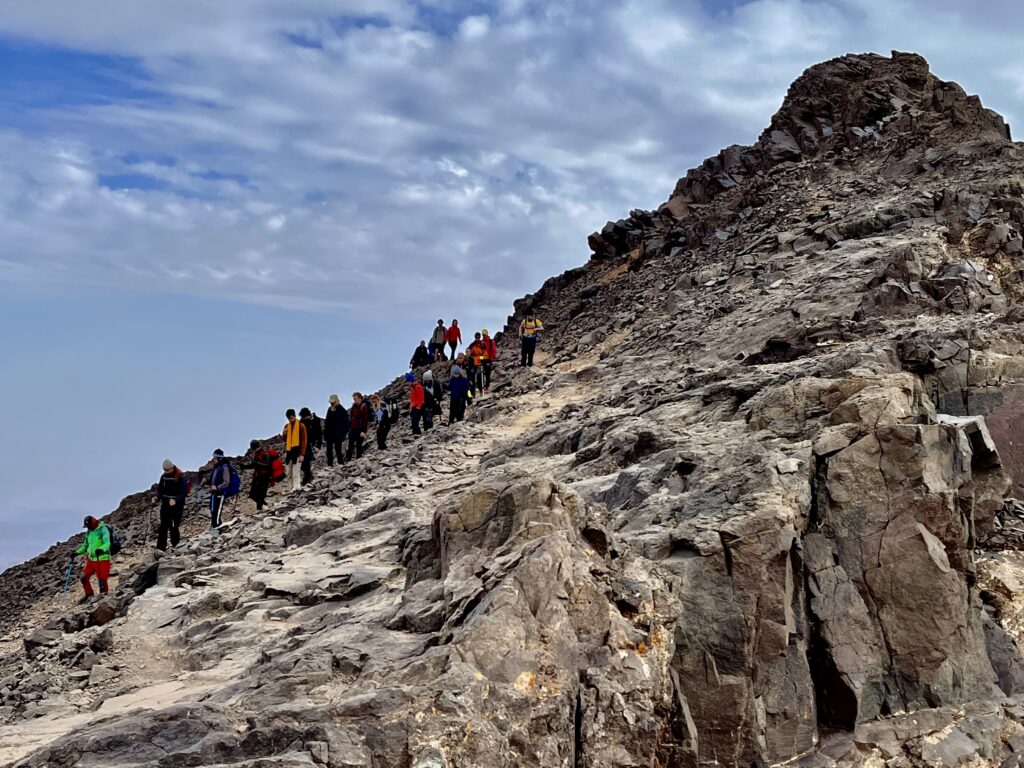
Introduction:
As the highest peak in North Africa and the Arab World, Mount Toubkal climbs to a breathtaking height of 13,671 feet (4,167 meters). It has recently become a hub for tourism in Morocco, with a thriving guiding industry taking shape in the local village of Imlil. From the top of Toubkal, hikers see the dry, defined mountains and ridges of the Atlas from above, all within the protected Toubkal National Park which spans over 38,000 hectares.
Mustapha Bouinbaden (who owns the local Toubkal Trekking Adventures) explained to National Geographic, “Some visitors don’t expect high mountains and snow in Africa — they also don’t expect the hospitality of the people. The people are always smiling, they joke. In this area, people really welcome tourists.” Bouinbaden’s remarks couldn’t be more correct – the people residing in these small mountain villages are among the kindest and most joyful I’ve met.
This guide is structured so you can learn the logistics surrounding a day, or multi-day trek to Jbel Toubkal in a question-and-answer format. However, if you are looking for specific information take a look at the table of contents below:
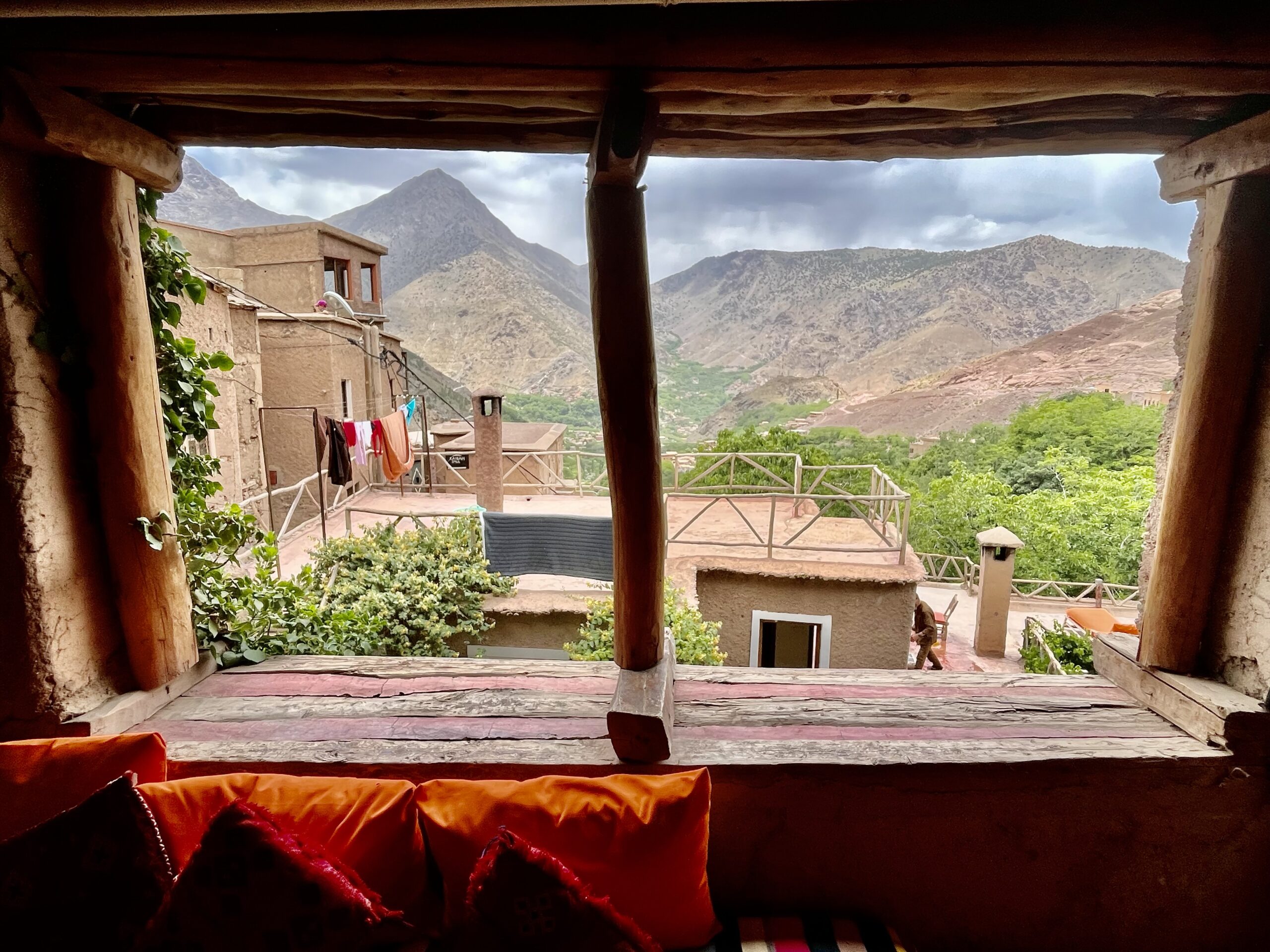
YOU MAY BE WONDERING…
General FAQs:
Do I need any technical climbing skills for the hike? There are no rappelling or rock climbing skills required. Toubkal is trekking on maintained trails from start to finish.
What is the difficulty level of climbing Mt. Toubkal? Do I have the required fitness? To climb the mountain over multiple days you need to be in reasonably good shape. The average weekend warrior backpacker with a love of the outdoors can easily accomplish Mt. Toubkal.
What’s the best season for a trek up Mount Toubkal? It is possible to climb Toubkal any time of year, and guides operate year-round. The most accessible seasons for climbing are fall and spring where a lack of snow couples with manageable heat to make for easier trekking. Many hikers summit during the summer months (as we did), waking early to beat the heat. Other hikers visit during the winter. They use crampons and generally take 2-4 days to summit but are rewarded with the clearest views of the year.
What essential items should I bring for a climb to Mount Toubkal’s summit? Essential items include sturdy hiking boots or gripped trail runners, wear layers (mornings and the summit can be chilly, but you’ll be sweltering by noon), water (bring two one-liter bottles and plan to refill at the refuge), snacks, a sun hat, sunscreen (if you usually wear it), a first aid kit, and a good backpack.
Is there straightforward transportation from Imlil to Marrakech or vice versa? For 800 Moroccan Dirhams (80 dollars), one can easily hire a taxi to take them from Marrakech to Imlil or directly to a trailhead. Toubkal Transport seems to offer a good service, but many companies will arrange a ride for you.
If you’d prefer to use public transport you can take a bus from Marrakech to Asni. Then, take another minibus or taxi to Imlil. This is a good resource. In total a trip on public transport should cost from 200 – 300 Moroccan Dirhams (20-30 dollars). Though some treks start from Imlil itself, (and this is a viable option) you could potentially cut off time (as we did) by starting at the national park entrance shown below:
Are there any cultural considerations I should be aware of while trekking in Morocco? As always, it’s good to respect local customs and traditions. Dress modestly, ask for permission before taking photos of locals, and ask about guidelines regarding waste disposal.
Do I need a guide to climb Toubkal? How much will I have to pay to hire?
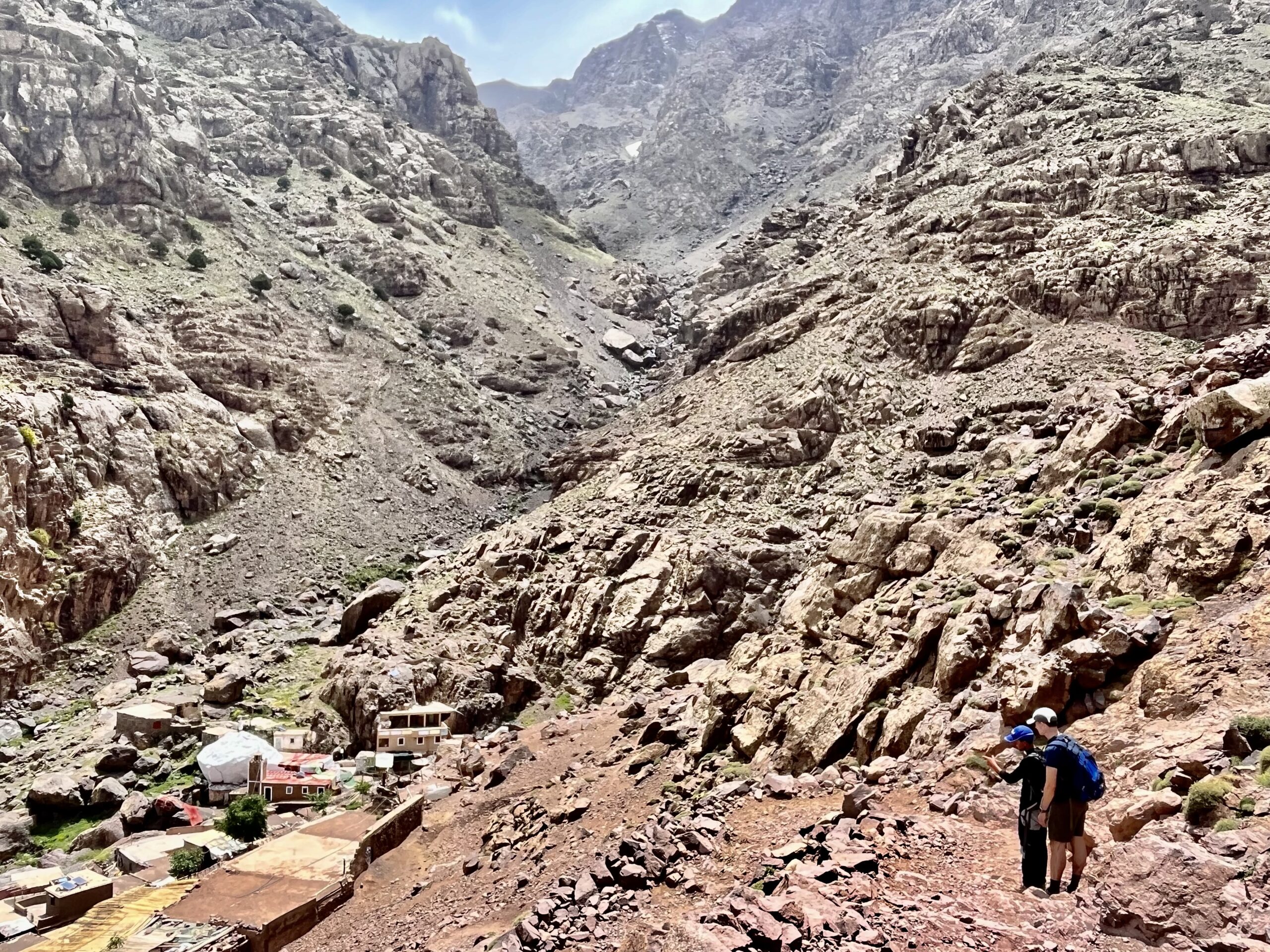
Is it necessary to hire a guide for a trek? Short answer – yes!
After a terrible 2019 murder on the mountain, the Moroccan government requires guides for trekkers. The government checkpoint along the main path enforces this rule by requiring passport checks. Though hiking from the east is a unique experience that might not require a guide, I doubt tourists save money with this option. It is remote and only logical for extended traverses.
Hiring supports the community, yields a safe environment for everyone on the mountain, and allows for greater cultural immersion. That said, there were unguided trekkers on the mountain when I was there. I will continue to update this section if regulations change.
What is a reasonable price for a guided Toubkal ascent? Most guides charge 400 – 500 Moroccan Dirham per day (40 -50 dollars). This price does not include food or other expenses. If you are hiking Toubkal in one day you can expect to pay closer to 800 – 1000 Moroccan Dirham (80 – 100 dollars) as you are fitting twice the hiking into one day. All-inclusive tours starting from Marrakech can cost up to 400 dollars.
Where do I hire a guide? For a multi-day trek, you can hire online. Compare providers, of course, but a few that I know of are Toubkal Trekking, Bureau des Guides Imlil, Toubkal Ascent, and Atlas Mountain Guides. Note: I have no affiliation with any of these services.
Is it possible to rent equipment locally before climbing Mt. Toubkal? Yes, you can rent equipment such as trekking poles and sleeping bags in Imlil or from your tour operator.
FAQs for Multi-Day Trekks:
How many days does a typical multi-day trek to Mount Toubkal take? Your average multi-day trek takes from 2 to 4 days, including the summit ascent. The slower pace allows for acclimatization and a more gradual approach to higher altitudes.
What kind of accommodation options are available during a multi-day trek? The refuge and surrounding area is a great “base camp”. Hikers can sleep in the refuge or in tents nearby. Many guide services also make camp here. Depending on the start point, hikers sometimes stay with local families in villages or at local hotels as part of a larger trek.
What permits or permissions are required for a multi-day trek to Mount Toubkal? Tour operators/guide agencies will handle any logistics for you. Currently, permits are not required.
What if I only have a day to climb Mt. Toubkal?

Climbing Mt. Toubkal in a day.
How physically demanding is a one-day hike to Mount Toubkal’s summit? This isn’t a walk in the park. Mount Toubkal’s summit is challenging due to the altitude gain and varied terrain. It requires a good level of fitness and endurance to withstand fast acclimatization.
Is altitude sickness a concern for a one-day climb? Altitude sickness is common at high elevations and Toubkal is no exception. While sick, it is important to hike slowly, but take fewer breaks. You should minimize your time above 12K feet as much as possible. If you hydrate well, you can expect some light-headedness, but it shouldn’t prevent you from summiting.
Can I do a day trip up Toubkal from Marrakech? A day trip from Marrakech is technically doable, especially if you arrange a private taxi. It would only be possible in the spring or the fall since heat and snow complicate things. Honestly, spending a night in Imlil or Tamatert is such a lovely experience. I’d consider it a must-do.
Do guides offer day trips up Toubkal?
It is impossible to find a guide service with a day hike option for climbing Toubkal online. Instead, you will visit Imlil a day or two before you plan to hike and ask about guides in the area. There are many outfitters in Imlil where you can arrange this. Explain that you’d like to climb Toubkal. (You probably won’t have to :). Offer anywhere from 80 to 100 dollars. Sizing you up in person allows guides to determine you are up to the challenge, so you must prove some experience.
Note: Many guides are locals with tons of experience taking people up the mountain. They will not necessarily speak good English or have fancy certifications, but they will get you up and down. Some outfitters may not allow their official guides to bring tourists up in a day.
TRIP REPORT:
Our Toubkal Backstory:
Unlike most hikes, very little planning was involved for Toubkal. I didn’t even know I was going to climb the mountain until the day before we set out. It was mid-afternoon when Jim and I decided to run from where we were staying in Tamatert down to Imlil for a visit. Jim had another agenda— to find information about climbing Mount Toubkal the next day. We had tossed the idea around before leaving home but had decided against it since we couldn’t find much information on the topic.
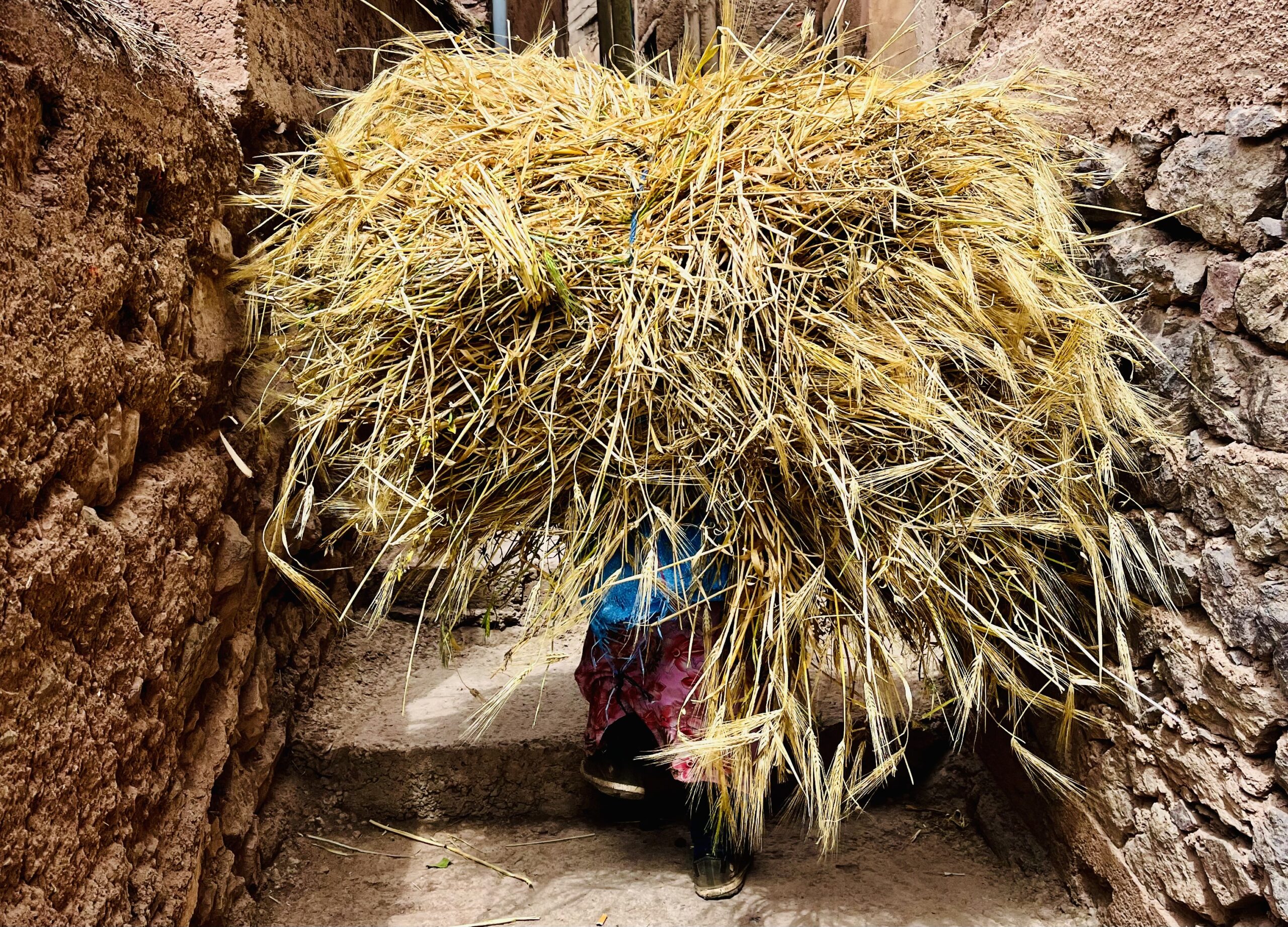
The village was vibrant; every next building hosted a guide service. Soon enough, we ducked into a gear store to inquire about hiking in the area. The gentleman in the store struggled to understand our English (we were definitely no good with Arabic), but he soon called a translator who came immediately. The translator answered our questions regarding climbing Toubkal in a day. He directed us toward a guide called Hassan and arranged for us to meet him at 3:00 AM.
In Imlil, just mentioning “Toubkal” connected us with many potential guides, in contrast to the digital confusion. Armed with a rock-solid hiking plan for the next day, we pushed on with our run, later making the final arrangements and resting up.
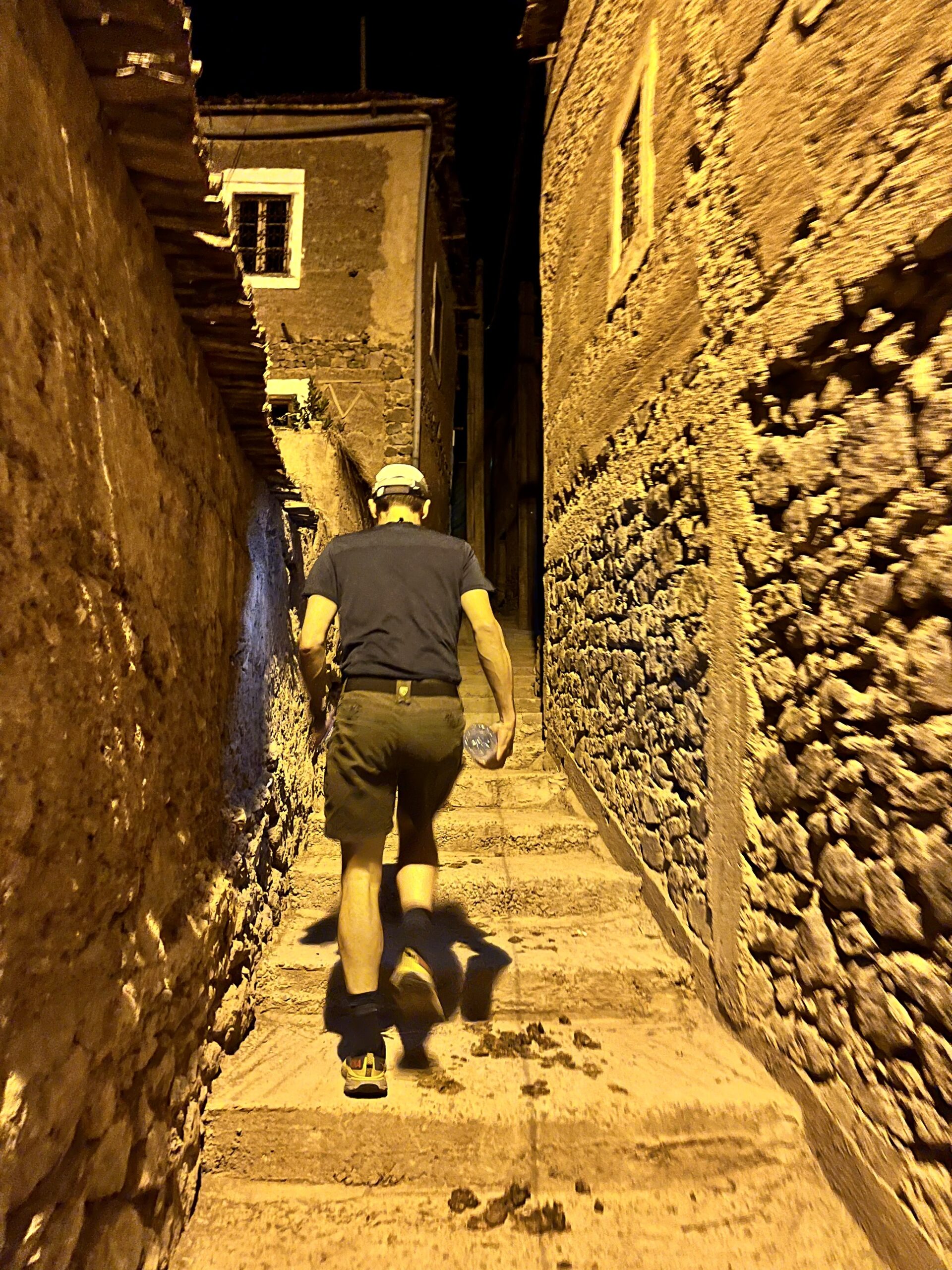
To Toubkal through darkness:
Rising before 3:00 AM, we walked up the steps to our designated rendezvous point on the narrow mountain road that wound through Tamatert. Stray cats dozed in dark nooks and a man aimlessly wandered down an adjacent set of stairs, smoking a cigar. Hassan’s headlights appeared at the top of a staircase, leading us to his compact van.
The old stick shift sputtered to life, propelling us into a series of hair-raising turns on the exposed road. We passed a waterfall, wound through the tight streets of another mountain town, and went over a steep hill. The van’s wheels occasionally dug into the earth, forcing Hassan to accelerate. Soon, we rolled into a dirt lot. A sign marked our entrance into Toubkal National Park.
We focused on the path ahead, lit only by our headlamps, that crossed a rock field with dark mountain silhouettes on three sides. I stumbled, an early fall didn’t bode well for my road runners and their limited grip. We progressed steadily, ascending gradually with each step. Dim buildings, including a military checkpoint, gradually emerged, almost unnoticed until we were nearly upon them. Then, we crossed a bridge, ascending switchbacks above the river-carved canyon. Every bend left a sense of a pass above, a mirage-like height of land forming with each turn.
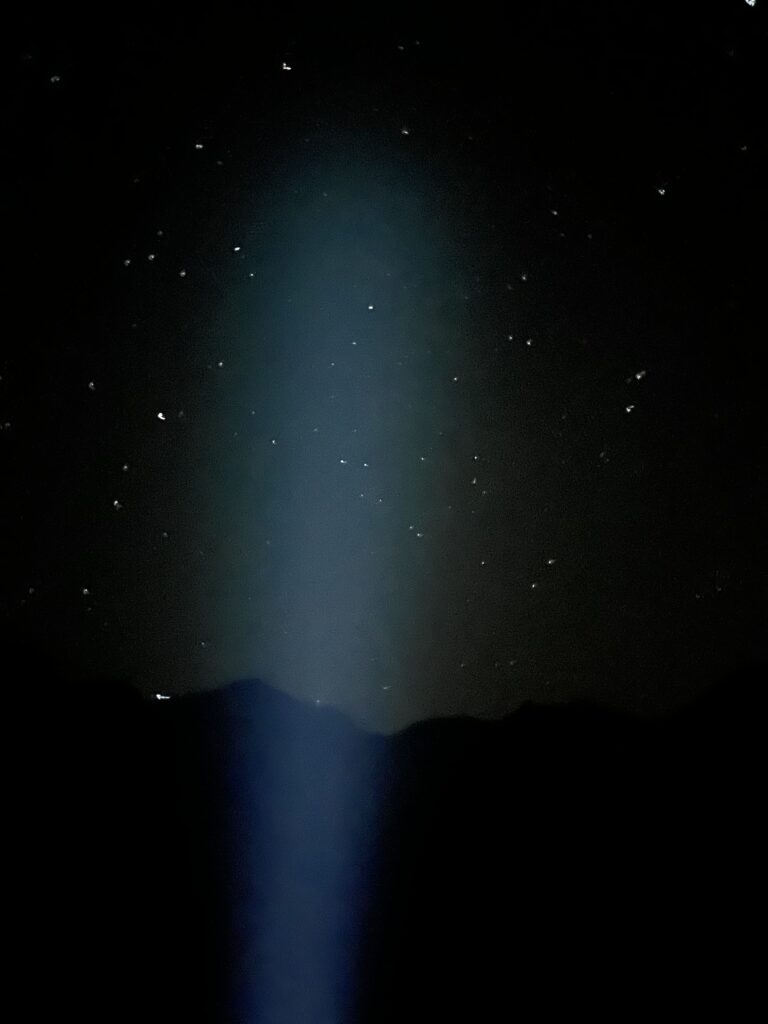
We passed an outpost that seemed to sell concessions by day. Hassan found a rock bench, and we shared Snickers bars and wafers outside the closed store. It was still dark, but there were signs of impending sunrise at the base of the ravine. Hassan asked us to give him a moment as he climbed above the trail. It was just after 5:00 AM – time for his morning prayer.
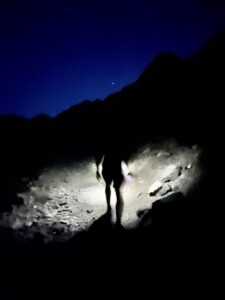
Reaching the Refuge des Mouflons:
We continued to climb as the trail steepened. As the sun began to rise above the horizon we finally crested into a basin. Twinkling lights in the distance let us know we were nearing the refuge. Pack horses and tents littered the plain leading to the lodge, a building that looked more European than Moroccan.
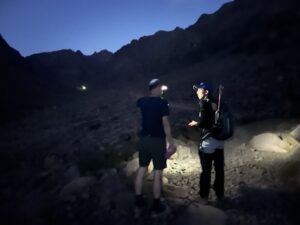
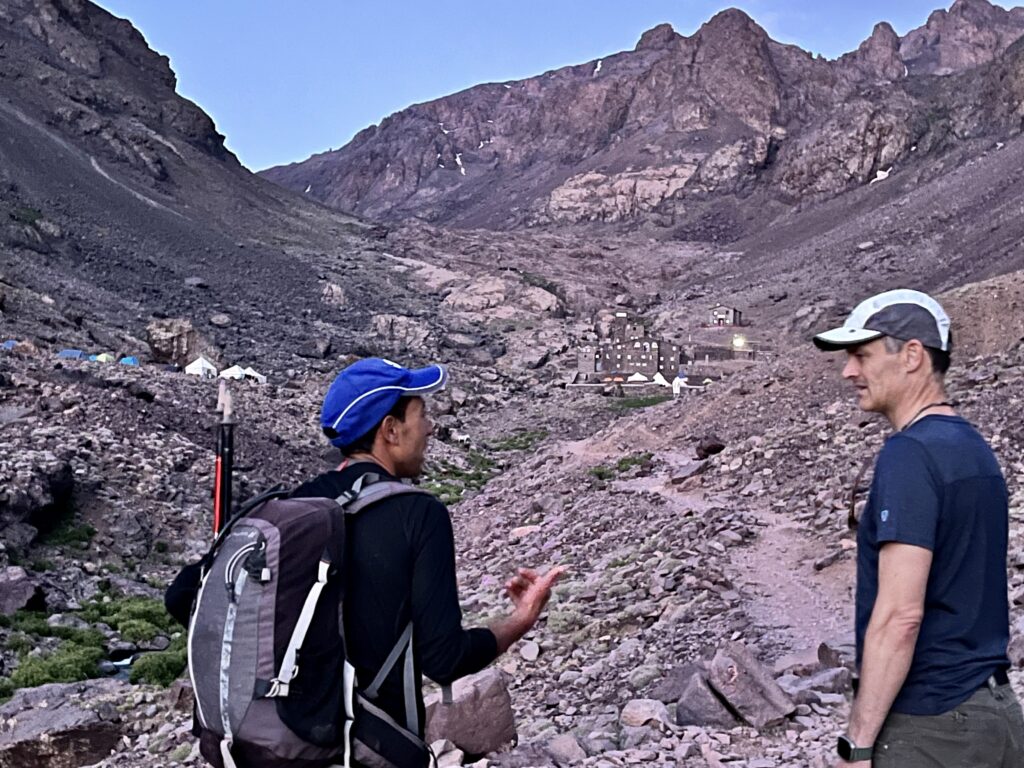
We soon crossed this plain and entered the building. The sun quickly climbed into the sky, just in time for breakfast. The day appeared as clear and beautiful as we had hoped.
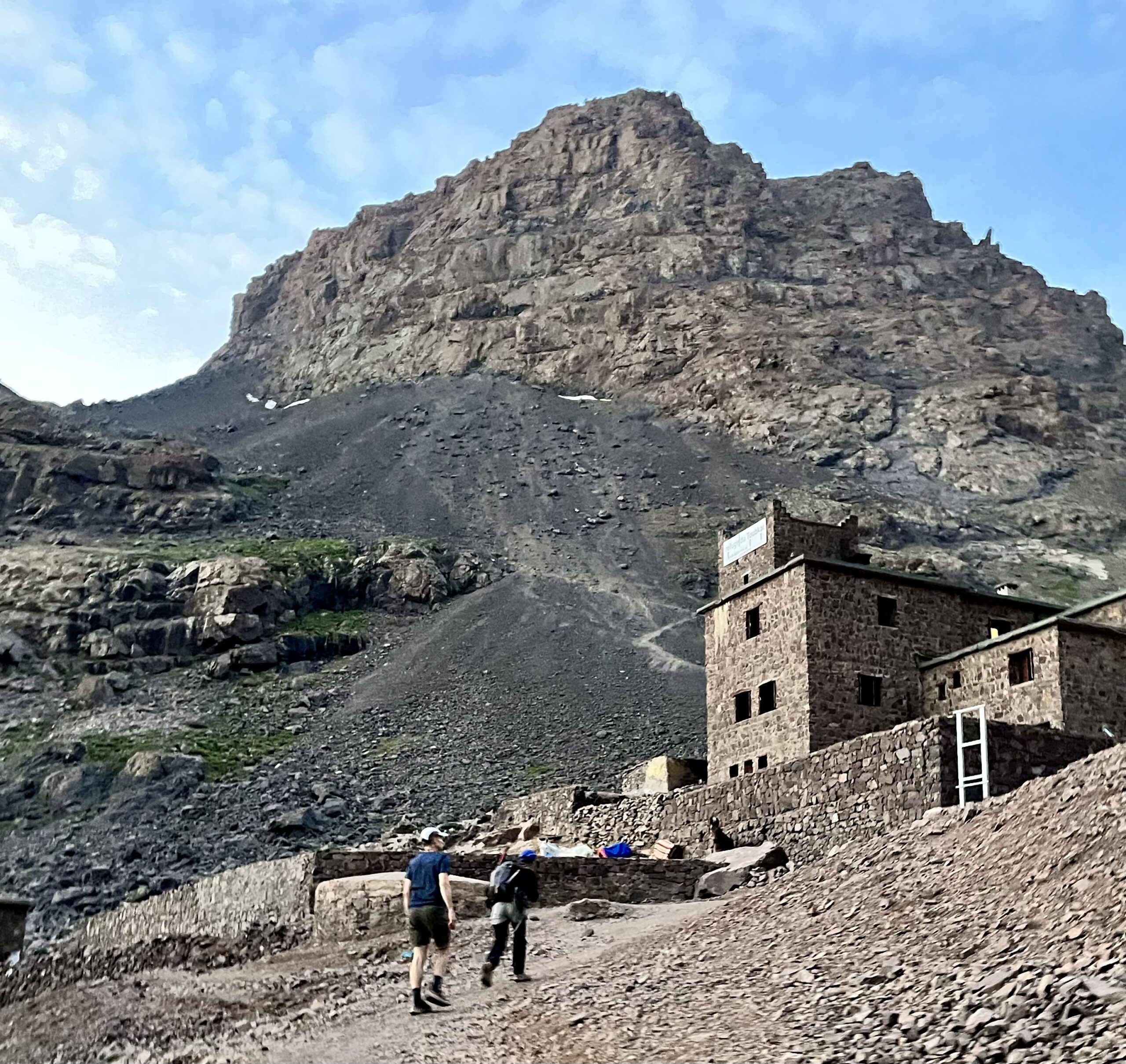
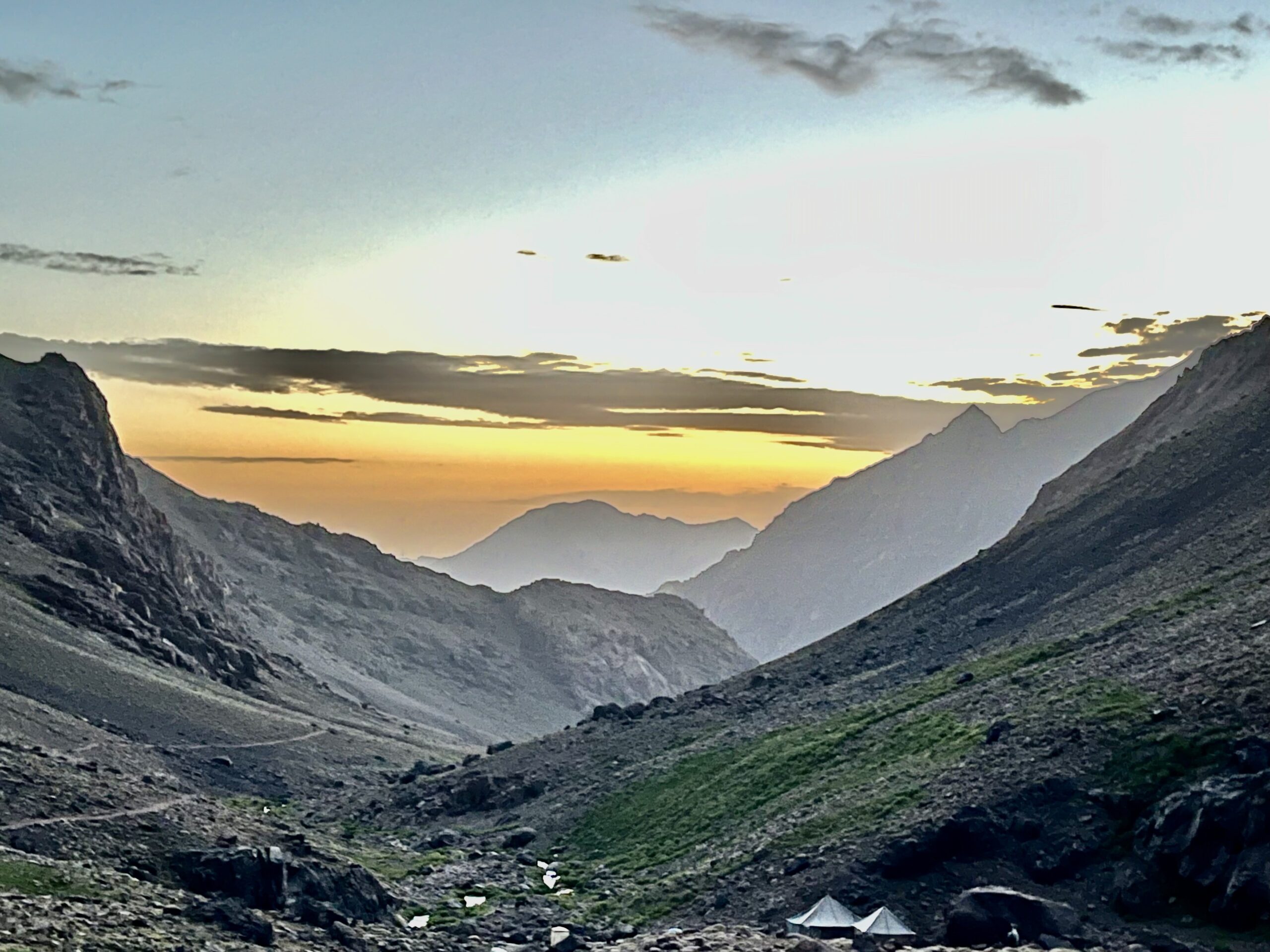
Inside the refuge, a caretaker dozed in a chair surrounded by snacks and other items for purchase. Hassan apologetically woke the guy, who allowed us to purchase breakfast. We got coffee, hard-boiled eggs, and bread with olive oil. Perfect! After stocking up on provisions, we were ready to start the steep ascent onto Toubkal itself.
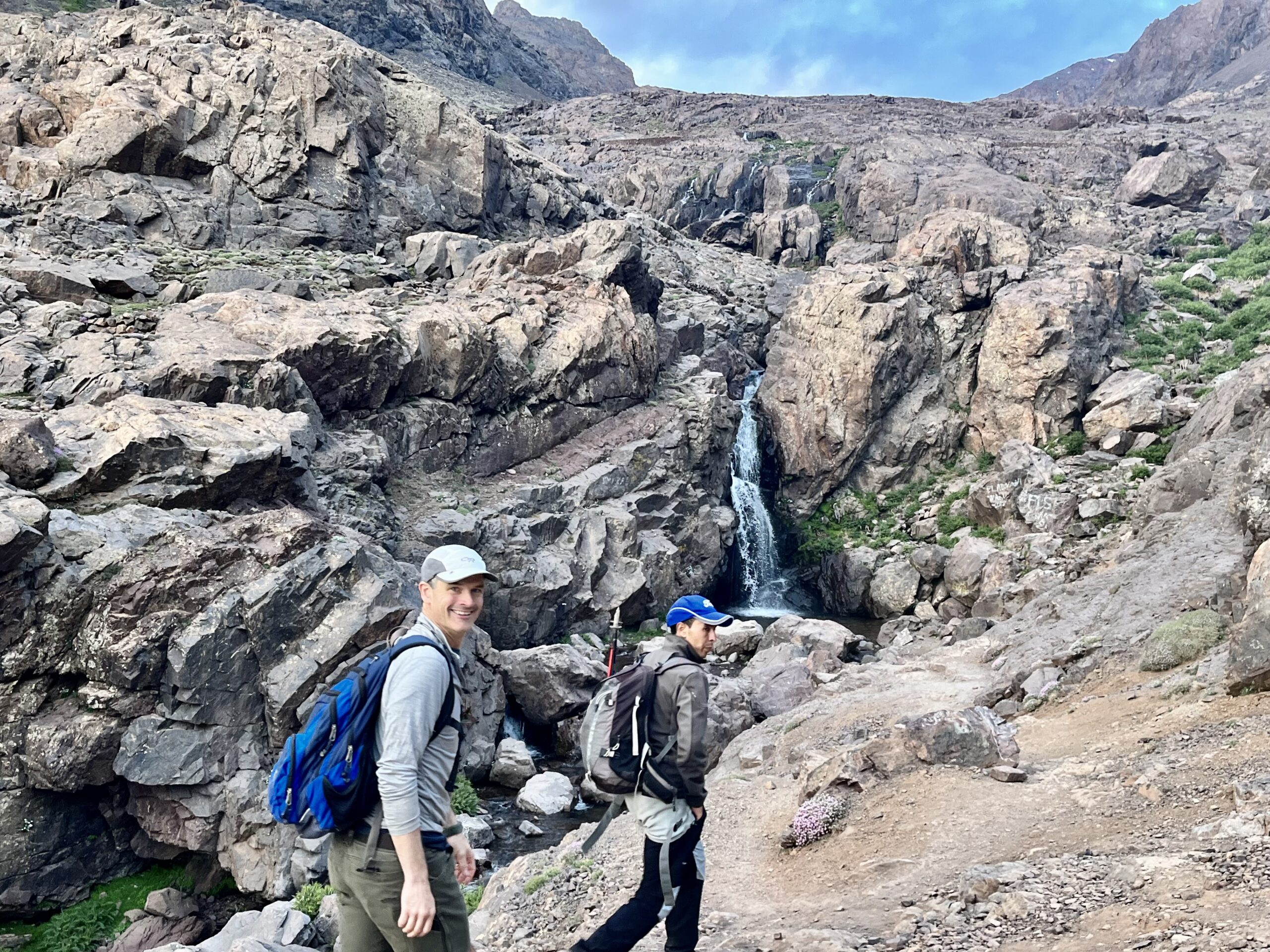

Toubkal Summit Push:
We turned southeast, following the road most traveled. Soon, the trail became less defined as we traversed a large rock field. From above, we could see the vast network of trails meeting at the refuge. My only regret was not having more time to hike them too! After gaining 1000 feet, (in just three-quarters of a mile) the terrain softened as we entered another ravine. There were many interwoven paths leading to the pass ahead, but some must have been social trails. Thus far, the altitude had forgotten to affect us. Two days earlier we had been sweating in Marrakech’s 111-degree heat. Now, we were bounding up a slope to touch snow!
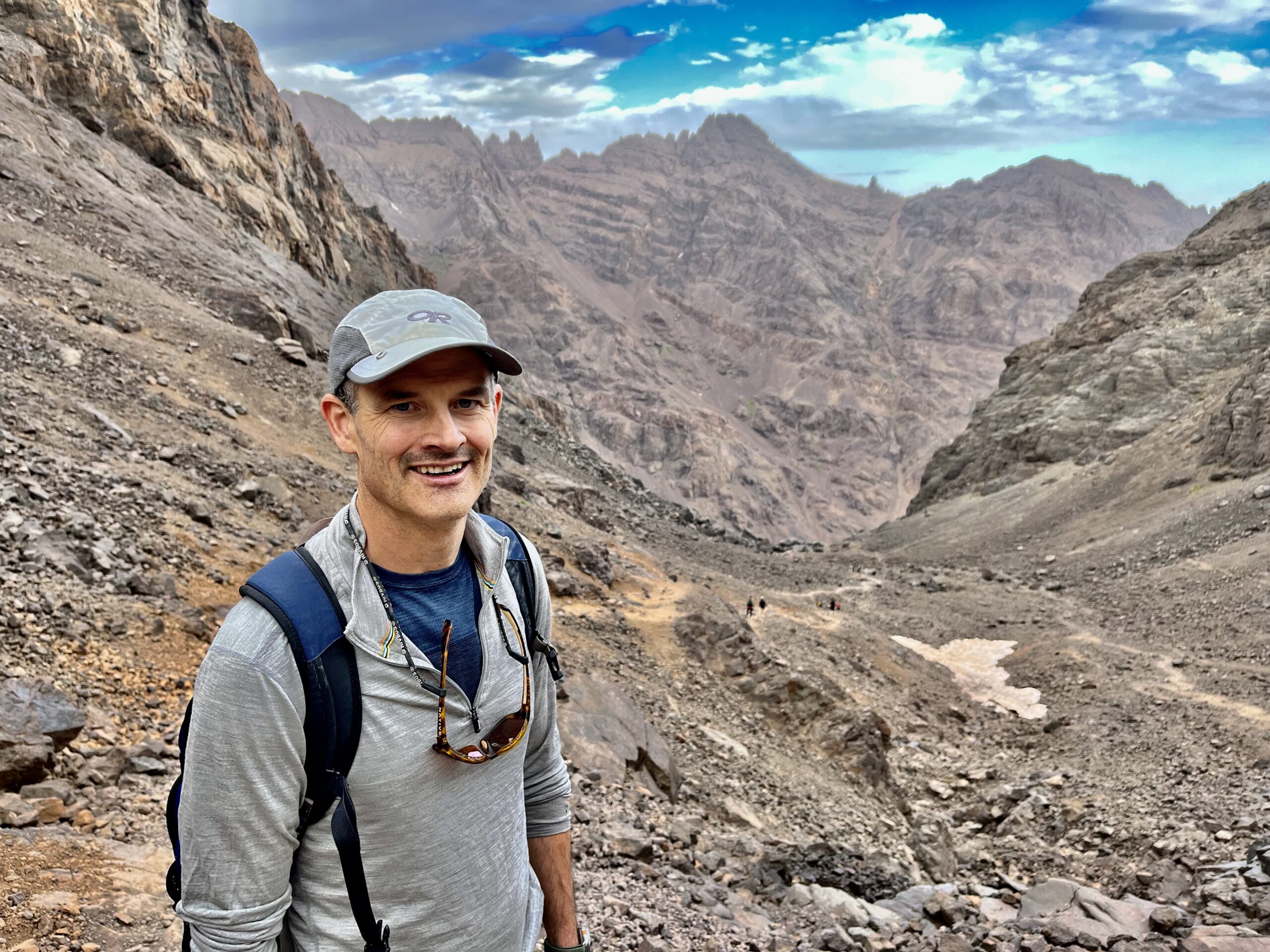
Unfortunately, neither the trail’s gradual ascent nor our pace could last. At over 12,000 ft, we shortly encountered a steep gravel slope that separated us from the pass, where the path turned northeast for the final push to the summit. Following switchbacks to the top, Hassan led us in a steady march to the crest.
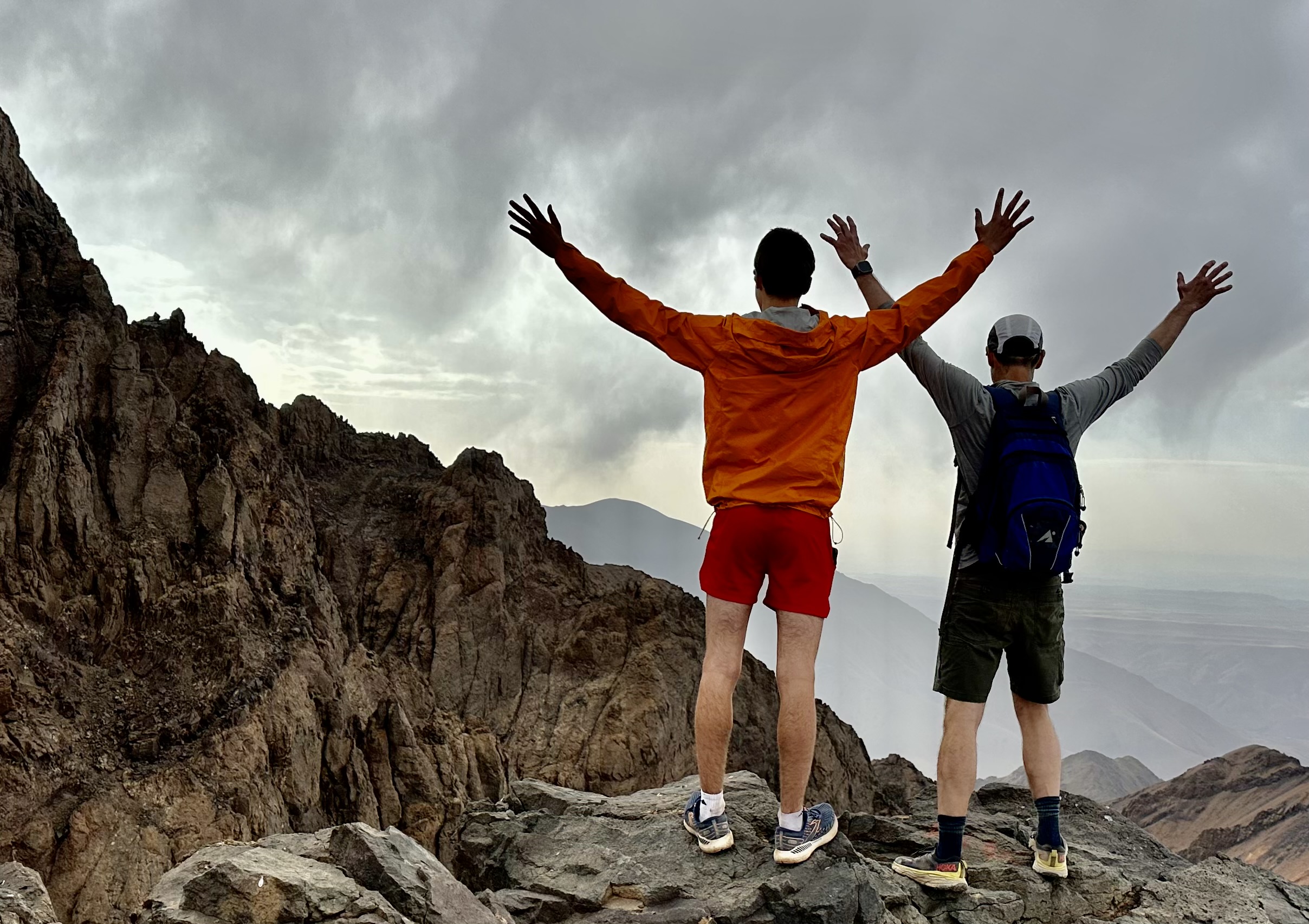
We stood in a saddle between Toubkal’s western peak and the mountain itself. The views were incredible, but the most striking was the diverse geology.
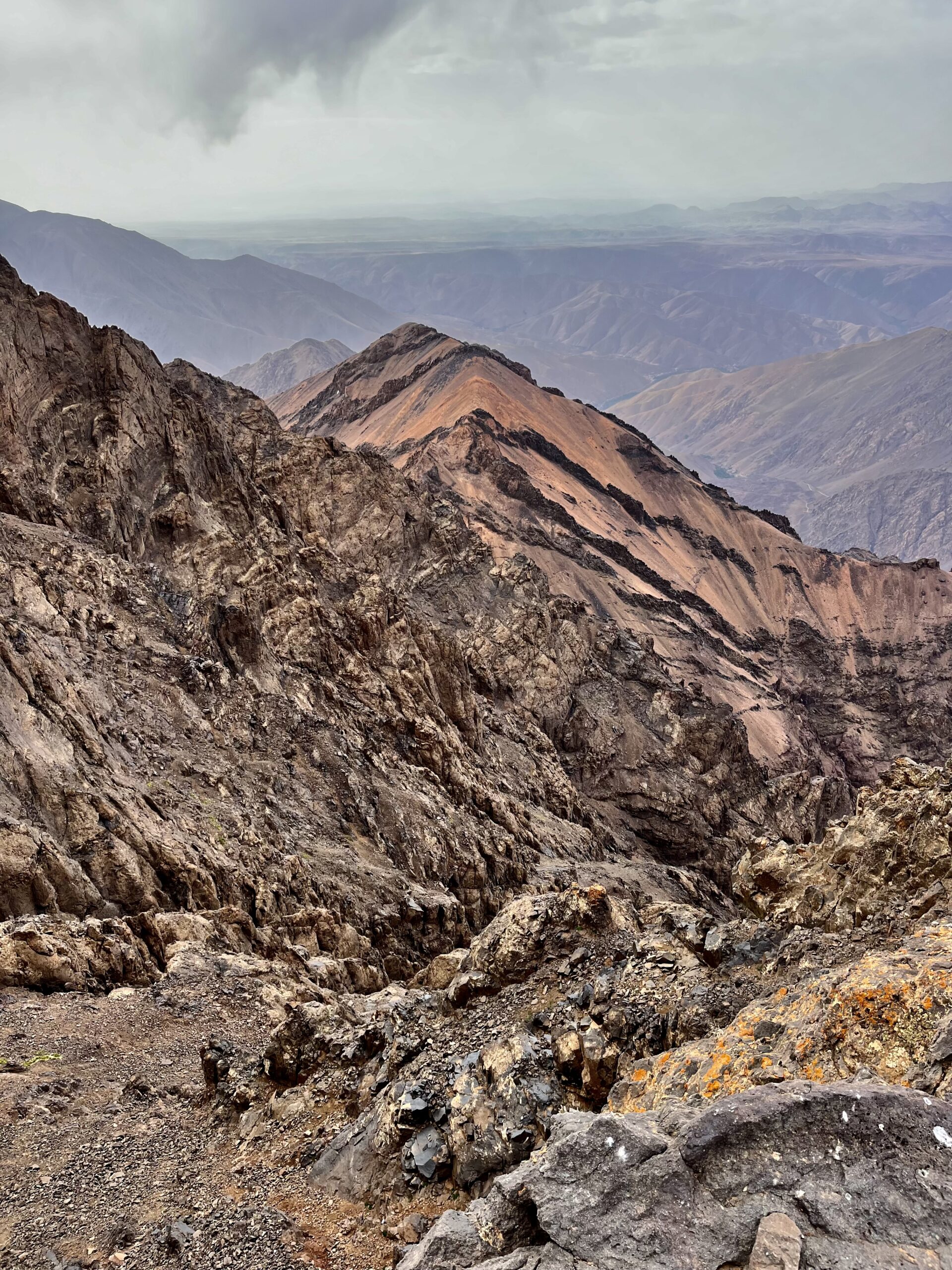
With the summit within view, we countered toward it. I planned each step as my shoes struggled to gain purchase on the slabs of rock. Nearing the peak we met a group of over 30 hikers with many guides between them. Hassan greeted each guide with a pat on the back or a handshake. What a friendly guy! The iron pyramid, synonymous with Toukbal’s summit, was now just 200 ft away. I started sprinting, only to find myself gasping for breath shortly after. Fortunately, I had just a few more steps to cover.
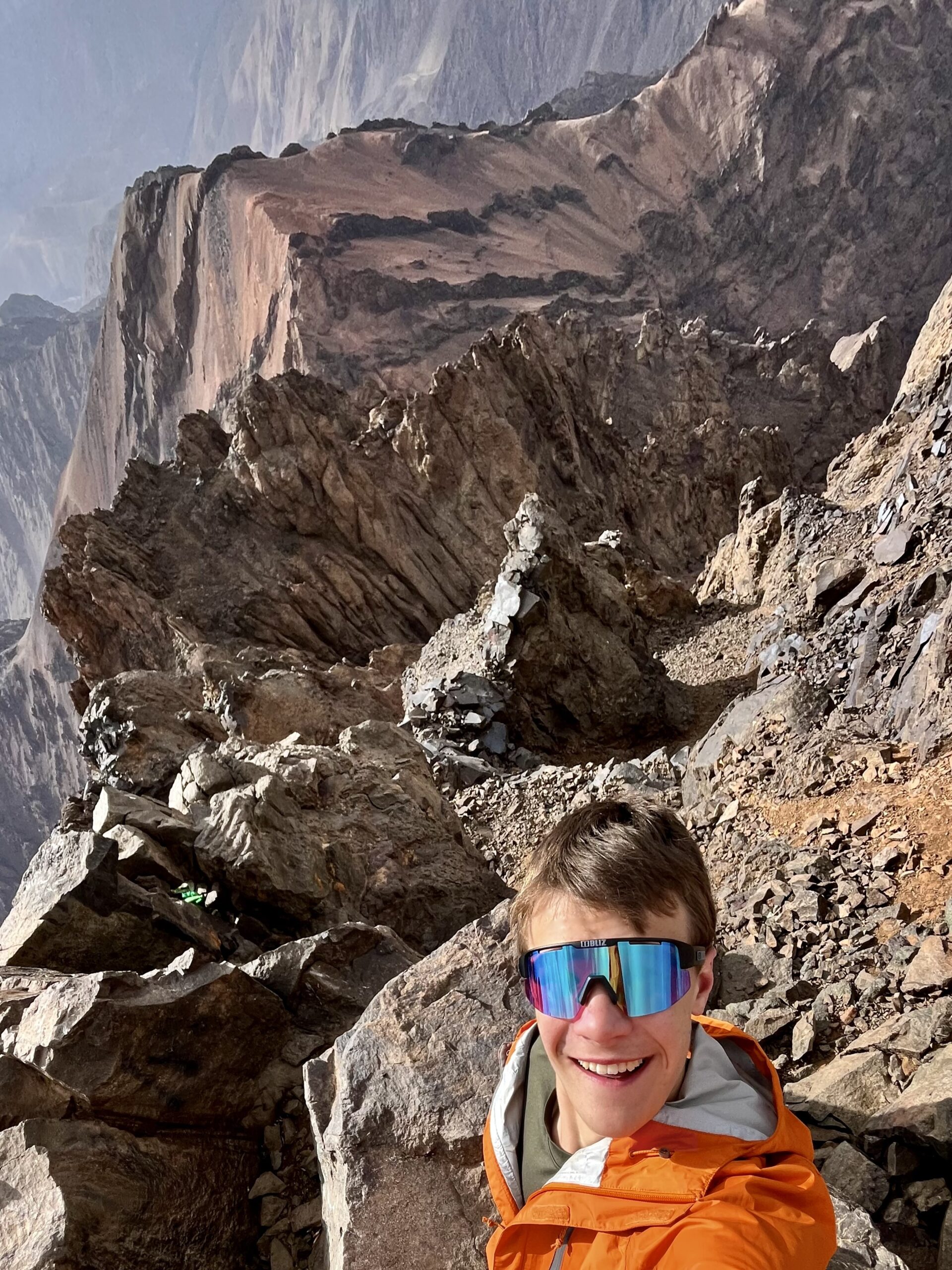
Back to the Refuge:
Leaving the packed summit, marveling that it was only nine, I soon realized my shoes and the scree weren’t cooperating. With heads pounding from elevation, Jim and I picked up the pace. Oddly, a quicker stride worked better on the slippery rocks, but Hassan soon advised against it, emphasizing a slower approach. “Slowly, slowly” became his descent mantra, as he was clearly focused on avoiding any injuries among us.

I minimized the ol’ jump, slide, and run out of respect for Hassan. Well-traveled through these mountains, he could easily identify all the nearby peaks. Our conversation touched on other alpine regions in Morocco, yet I got the impression that few mountains could rival its highest peak.
The path forked into many lines leading to the base of the ravine. We altered our route down slightly but soon found ourselves in sight of the refuge. There was little to do but plod toward the promised break. Customary mint tea for everyone!
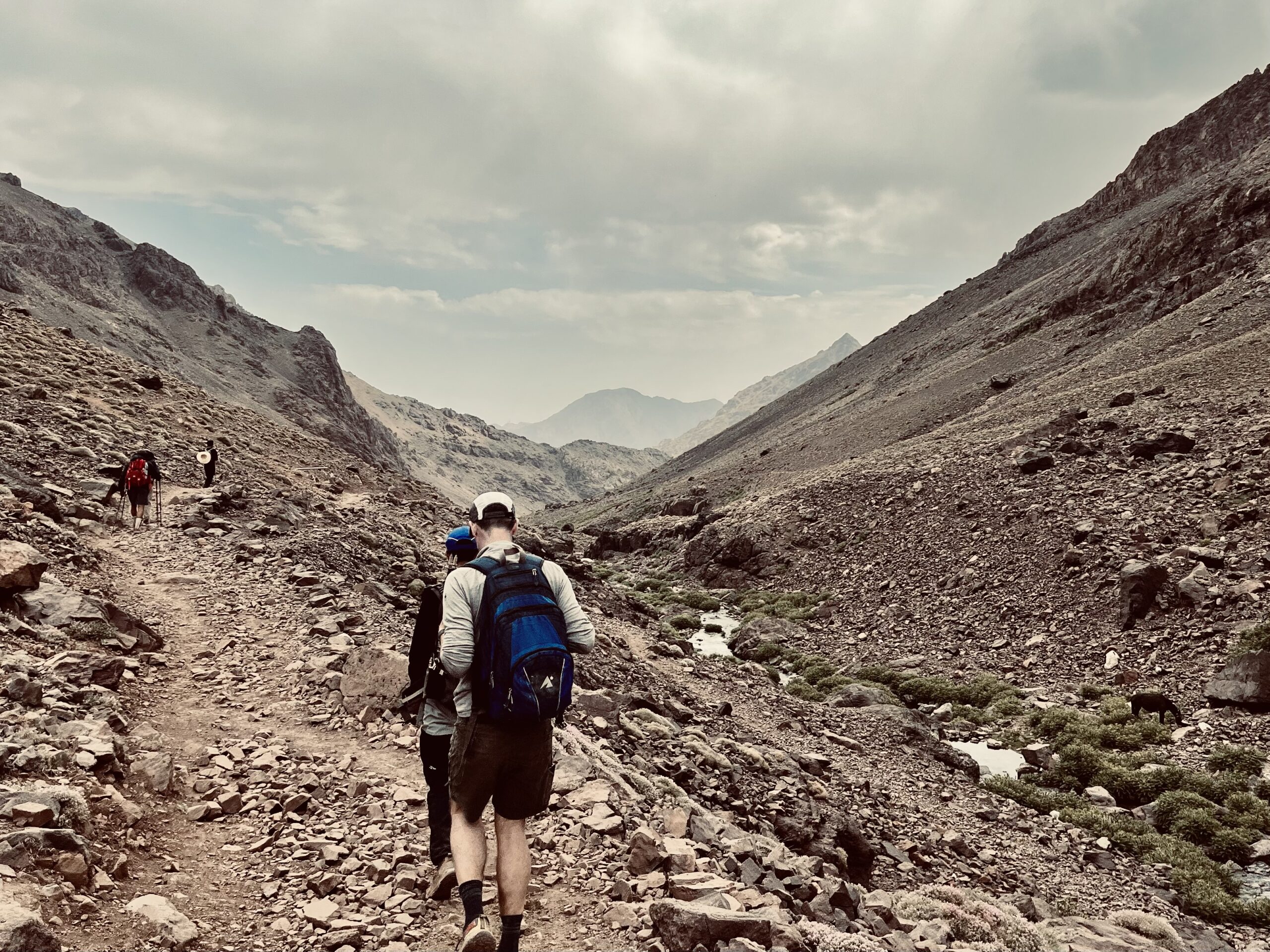
Trekking back toward Sidi Chamharouch:
After regrouping with tea and snacks at the refuge, we aimed to descend in good time. While crossing the initial basin, we found that the elevation profile was the only thing reminiscent of our hiking that morning. Instead of vague silhouettes, we could now discern distant peaks from those nearby. The noon light exposed the local flora and how the stream shaped the arid canyon. I forgot to watch where I was going. Then, I stumbled and inadvertently dropped my phone, resulting in a dent; not exactly the souvenir I’d hoped for.
Down the mountain, there was an endless stream of goats following the path ahead of us. We were intruders on their grazing lands.
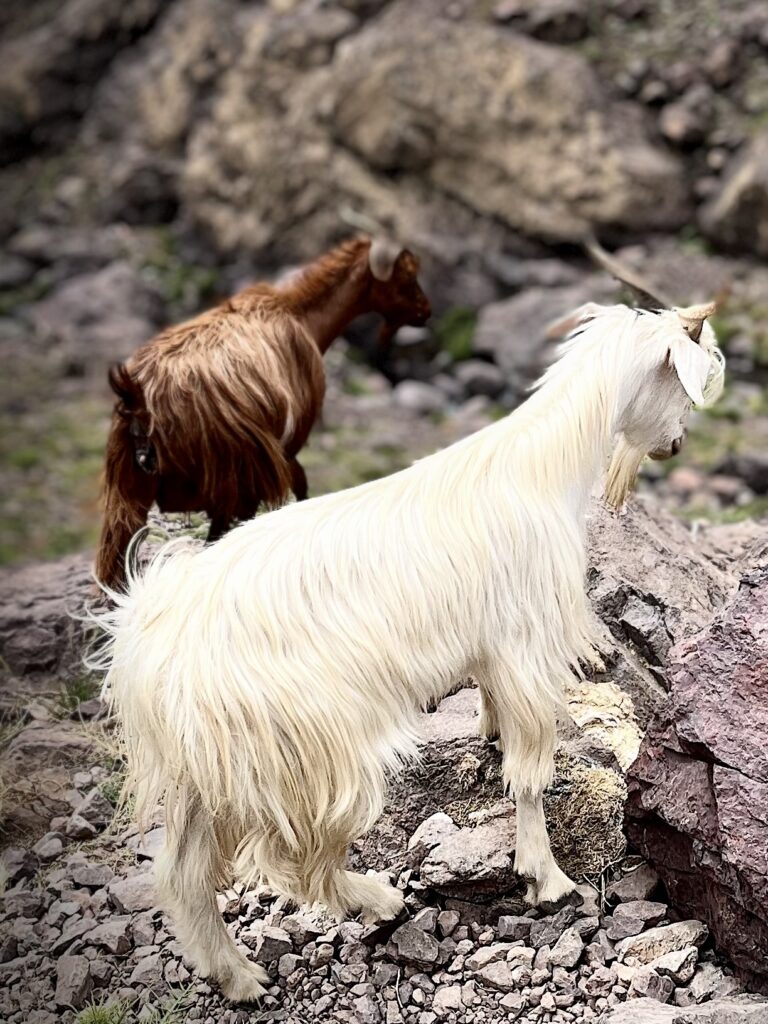
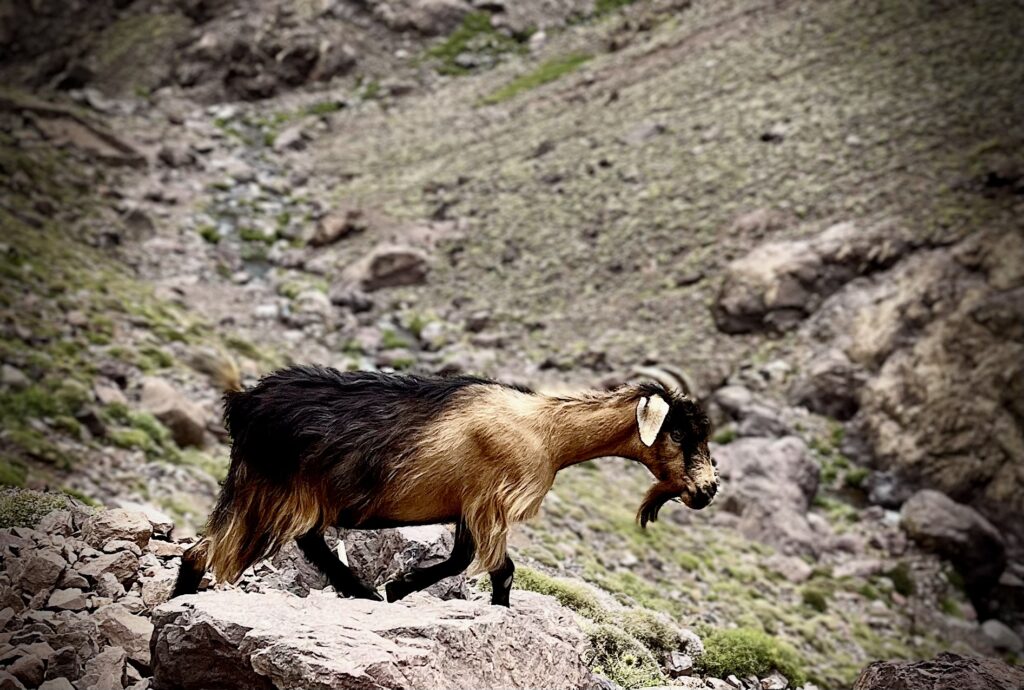
Hassan explained that the goats belonged to herders who owned property nearby. They were allowed to roam the surrounding areas.
We continually passed horse riders, carrying food and supplies to the refuge. Hassan knew each one of them well, greeting them by name and stopping to chat. He was clearly a friendly person, but Moroccan culture is also much more interactive and communal compared to norms in the US.
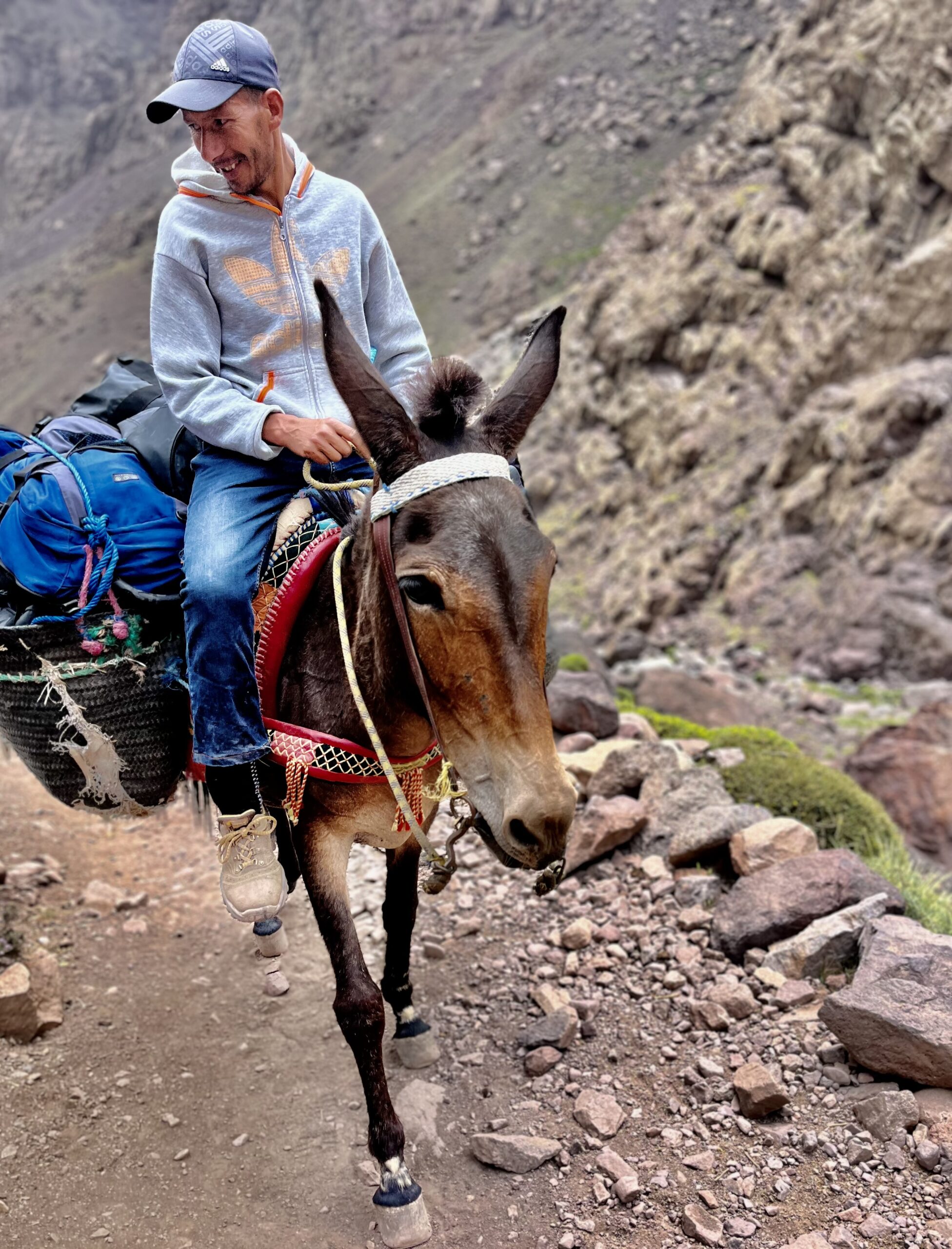
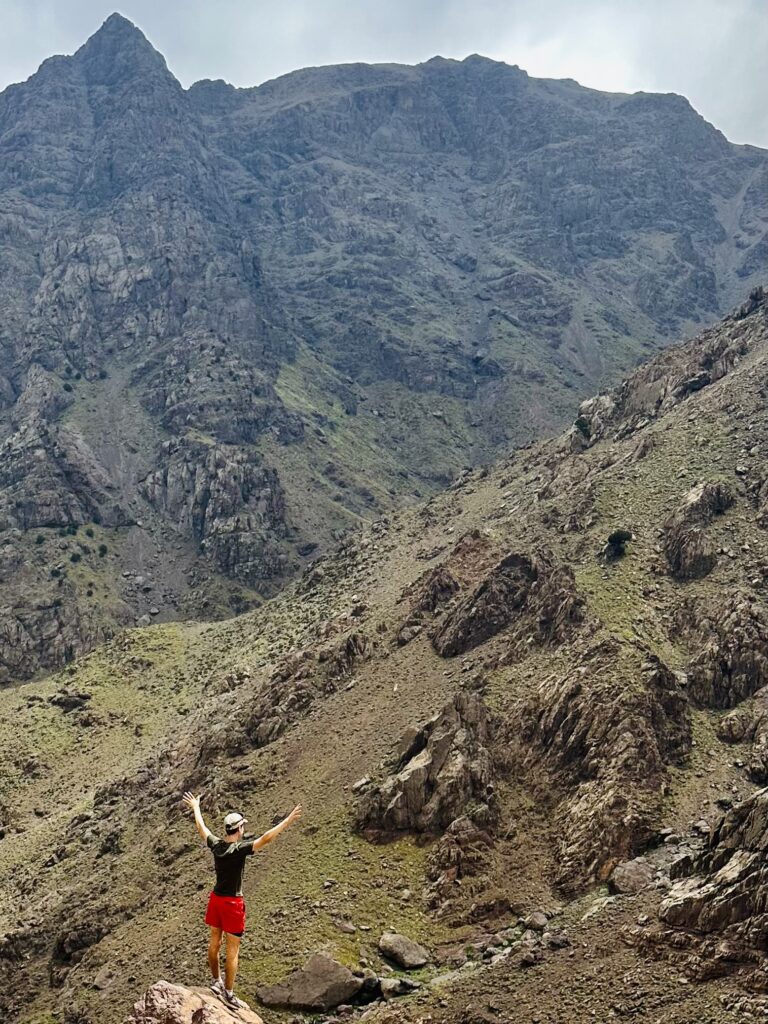
The final stretch out to Aroumd
Below, the trail wound into switchbacks, and in the distance, we could make out the buildings of Sidi Chamharouch, an ancient mountain hamlet transformed into Toubkal’s concession stand. As tourists near the end of their treks, they can stop and enjoy a cold drink or some local fruits. Hassan soon led us into an open-air restaurant. We all got drinks and he talked to the owner who happened to be his friend.

After our cliffside meal, we followed the last switchbacks down to the river. Crossing a bridge, we followed a wide herder path reminiscent of Bright Angel in the Grand Canyon.
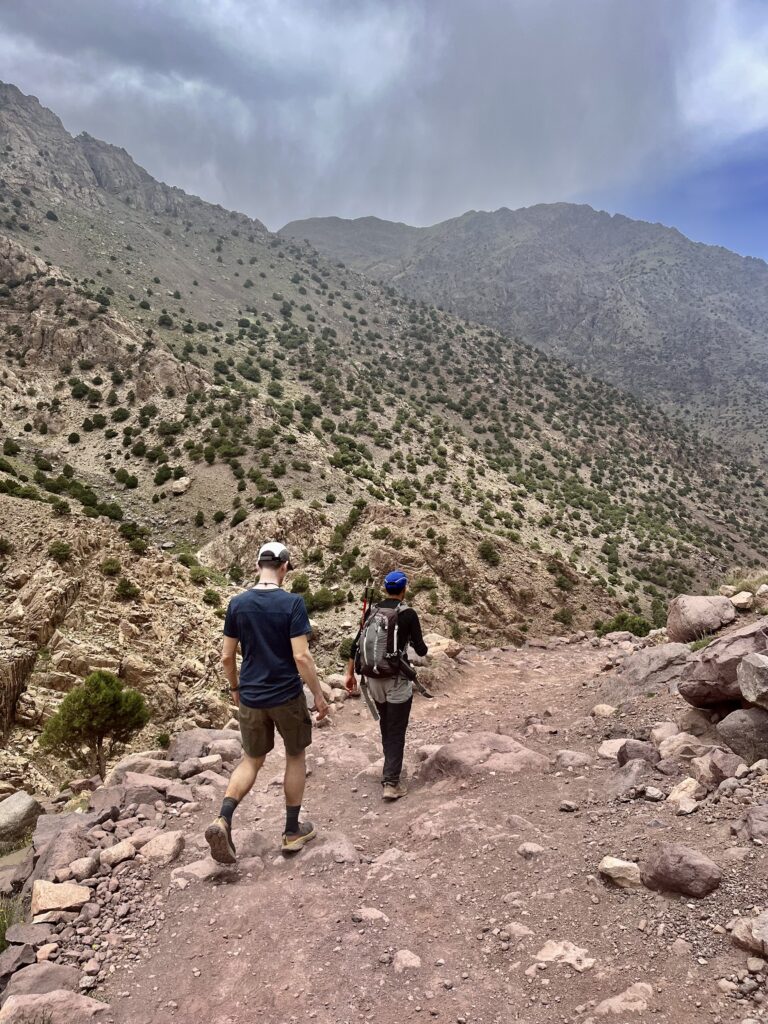
It wasn’t long before the military outpost appeared on our right. Surprisingly, we were not asked to show our passports. We took our last downhill steps toward the flats where we had started our day. Some people were riding to Sidi Chamharouch, a pilgrimage site for many Moroccans. From the wide valley, we had a picturesque view of the village Aroumd. It was 2:00 pm, and we were only just starting to notice the heat.
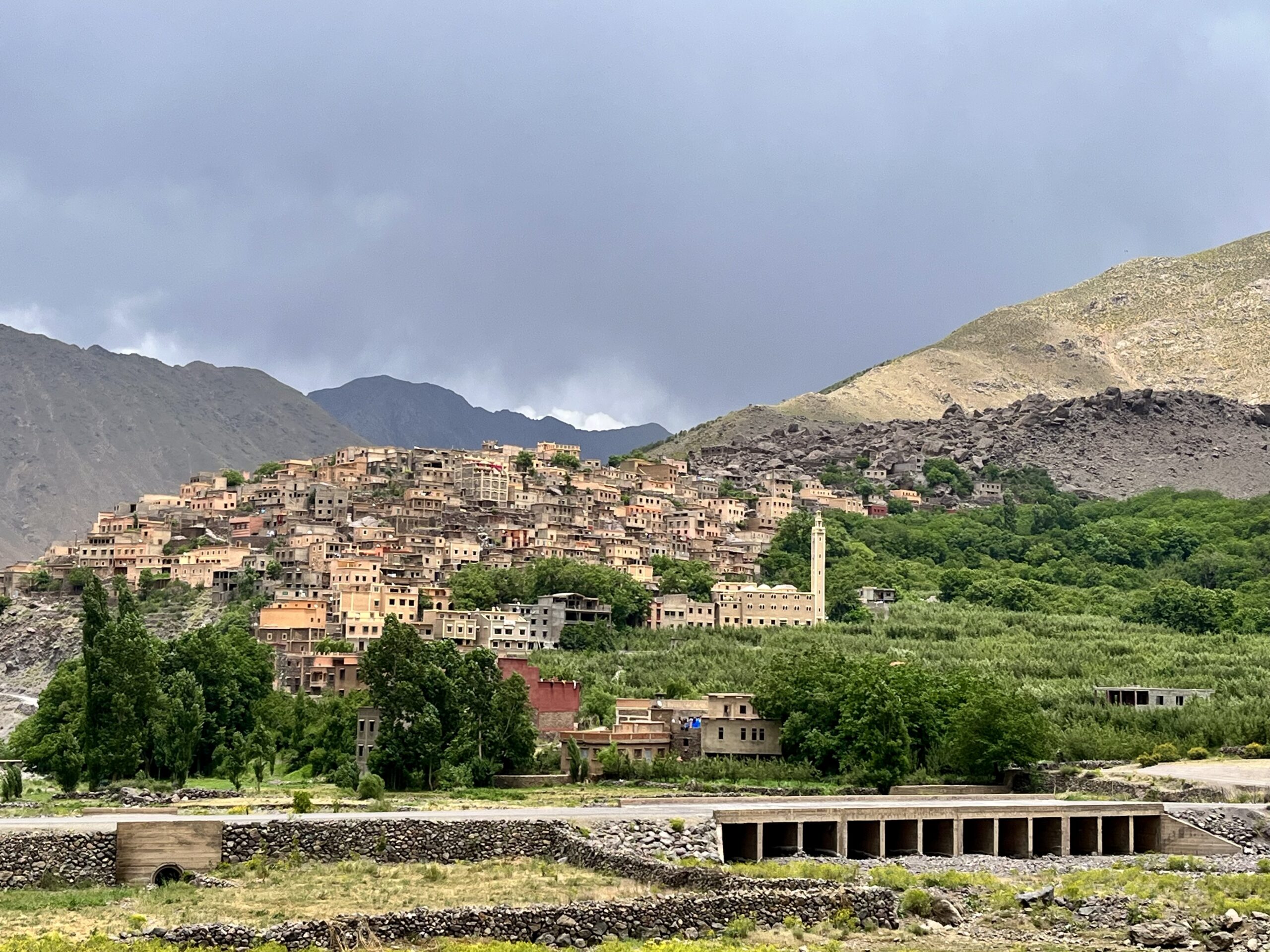
REFLECTIONS:
This year I’ve had two epic cultural experiences through trekking. First, in Guatemala on the Acatenango Volcano and shortly after in Morocco. It has soon become clear to me that one of the best ways to explore foreign cultures is by trekking. What’s more, walking causes me to see more similarities between the world’s cultures than differences.
Equally important to the cultural experience is the climbing itself. Toubkal wowed me in every way. Not only were the views stunning, but the profile of the mountain, from start to finish was enjoyable. From climbing alone through the dark to being immersed in the warm (and enterprising) Berber mountain culture to looking out over the dry, copper-colored Atlas Mountains from their highest summit, this trip was something to remember. One day, I hope to return to Imlil and cross over more peaks. For now, I can look back on one of the highlights of Morocco 2023: Jbel Toubkal.
Your post is interesting.
Very nice article! Do you have any contact for a guide? I will much appreciate it. Because We are heading there for one day trek with my friend in few months with same plan..
Hi Tom!
I am so sorry I missed your comment.
If you are still planning your trip at this time, I can try to help you find the same guide we had. His name is Hassan. If you are interested, I am happy to send you his WhatsApp contact.
Thanks!
-Ben
Hi Ben,
Great write up!Would you be kind enough to share Hassan’s contact details?
Many thanks
Bart
This article is fantastic! Keep up the excellent work!
Thanks for your post. I too would appreciate having Hassan’s What’s App information for our trip next May.
Anne (Boulder, Colorado)
Hi, I just found your post. I am looking to climb Mt Toubkal in a day too. I am going to Imlil tomorrow. I hope to get Hassan’s contact in time. Thank you very much in advance.
Absolutely! You are most welcome.
Hi. I just came across your post. By the end of the week I am planning to hike Mt Toubkal in a day as well. Could you also forward me Hassans WhatsApp number? Thank you very much!
What’s the roundtrip distance & total elevation gain of the route you took?
Hi CK,
Total distance was about 15 miles from Aroumd up and down. Going directly from Imlil or Tamatert can add up to 2.5 both ways. Our total elevation gain was about 8,000 ft.
Hi Ben, lovely pictures and great story! could you share Hassan’s contact details also with me, please?
Thank you… and absolutely!
Hi Ben,
We are in Imlil now and my husband is hoping to get up in a day. Could you please pass along Hassan’s contact information?
Thanks so much!
I hope you have a wonderful time there. It is such an incredible spot!
This is great, Ben – could you share Hassan’s whatsapp with me as well?
Hi Ben,
Great article, and thank you for sharing your experience. Could you pass along Hassan’s contact information?
Thanks very much.
Wow, these are some great tips you’re offering for tackling Mount Toubkal in a day — it’s always inspiring to see more people sharing their experiences about this iconic peak!
As a local from Imlil and passionate mountain runner, I actually offer this exact challenge as a guided one-day ascent through my website, Talamrout Summit. The hike is led either by myself or one of my experienced friends, all certified mountain guides and trail runners, making it a memorable, safe, and rewarding adventure.
If anyone’s interested in joining us for this incredible experience, feel free to check out the full details here:
https://www.talamroutsummit.com/service-page/toubkal-summit-one-day-hike-from-imlil-climb-north-africa-s-highest-peak?referral=service_list_widget
You can also drop me a message directly — I’d be happy to answer any questions or help you plan your Toubkal challenge!
WhatsApp :
+212771245210